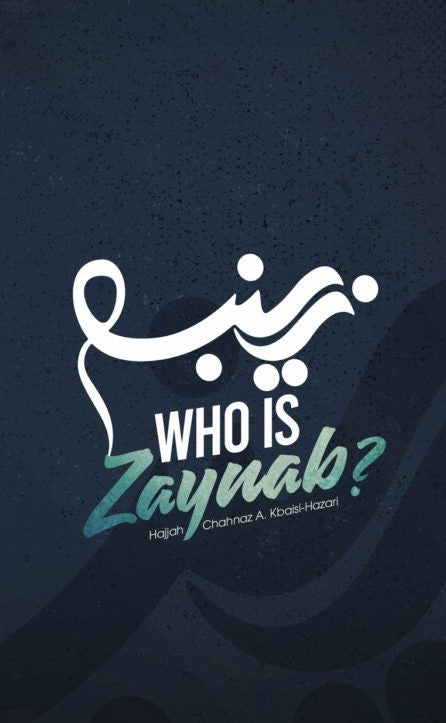Your cart is empty now.
Heighten the Mind

You may also like
al-Burāq Publications Completed Publications
"Who is Zaynab" ? is a title from Hajjah Chahnaz A. Kbaisi-Hazari. At the very outset, the fact
that it is penned by a Woman, with all the sensibilities that the feminine brings to the fore with
respect to the Tragedy of lossing brothers and her sisters, is very important to keep in mind.
One important thing to remember appreciate and recognize, Zaynab (SA) doesnt have a
hyphenated identity: her identity has it's own "Essence" and that is, that she is Zaynab (SA). She
isnt "the Daughter of Ali" as one Dr Ali Qaimi has set forth in his 700 page work, she is as
Shariati resurrected and preserved Fatima (SA) - she wasnt a hyphenated Identity other,
"Fatima is Fatima" and "Zaynab is Zeynab"
The book has some very beautiful features
1. It establishes the supremacy of the equity between the two genders, while also positioning it
within their respective "roles", and those roles tend to complement each other, for a society to
work and function with grace.
2. Aspects of a Societal belonging, what makes one and what brakes one are referenced from
the Holy Quran. It it important to keep in mind, that the Quranic verses enjoined, are meant to
serve as general principles with specific principles resonated from the beautiful ahl al-Bayt in
constructing a Society.
3. Very careful consideration is given to the themes, themes that resonate from the Quran, on
Gender Equity, of Genders working together, of placing the responsibility of enjoining goodness
and forbidding evil. That theme is the theme of Imam al-Husayn (AS), to reform to revive the
ummat Jaddi, all tracing their roots from the Quranic verses
4. The work impeccably adorned with historical references. Historical references can be
delineated in many constituents, those (a) that refer to the pre-Islamic Arabia, (b) then the
Sirah, that covers the Life of the Prophet Muhammad (S) both in Mecca and Medina (c) that
part of history that tarries it-self after the death of the Prophet (S) into the lives of the
Caliphate followed into the rule of Muawiya and Yazid. The work is a treat as it adorns itself
with historians like Ibn al Athir, at-Tabari
5. Then there this is very specific genre of historical work, known as Maqtal ("the death of"), so
there is the Luhuf, the Maqtal of al-Muqarram and Maqtal of al-Khawarizmi. When the
engagement begins in Karbala, these three works resonate and find themselves to the nucleas
of every activity. Maqtal al-Khawarizmi is the only non ahl al-Bayt source, but there are
elements of an oral tradition from the Imam al-Husayn (AS) and his Comparison that are not to
be found any-where else. The Maqtal literature is the what, who and how a devotee of Imam
al-Husayn (AS) attained martrydom - the details are, we are aware from our oral tradition in
sharing the tragedy
6. The Ziyarah literature also forms the basis and praxis of the believers allegiance to and ascent
from the banality of a life without purpose into the realm of those who attained martyrdom in
Karbala.
Now lets conclude this with the most important aspect of this work
1. Zaynab from the moment of her inception, was "always" aware of what was going on in the
family. If it wasnt here acute sense of observation and wisdom, she made her place in the lives
of her grand father, the Prophet (S) and her siblings. No Zaynab left behind, even if you try, fail
you will
2. The household of the ahl al-Byat, as I garner from the work, always made the entire family
informed of what was going on in their lives, how it would impact them, as history would
unfold. Those patriarchal notions of Women being the weaker sex and un-able to face the
challenges of a family, was a by-gone conclusion with Zaynab (AS)
3. Zaynab and her sense of awareness, to put it like a metaphor is like a hawk whose eyes and
sense of heightened space, is well aware and calculating very move as history unfolds. Imam alHusayn (A)S
would constantly remind her of her role, and she was always aware of it at-hand
before hand
4. The level of clear communication assured between al-Husayn and Zaynab, his final role and
Zaynabs role in picking up after the tragedy of her brothers loss. Imam al-Husayn (AS) reminded
Zaynab of the awesome responsibility of her becoming, over and over, and that reminded was
duly attached it-self to the heart of Zaynab. Again certain cultures would rather keep Women
out from the realm of war that brings death and tragedy - but Zaynab embraces it - like a baby
embraces her mother

![Karbalāʾ: The School of Supreme Values [PRE-ORDER]](http://al-buraq.org/cdn/shop/files/IMG-5615_large.jpg?v=1752565881)








